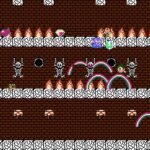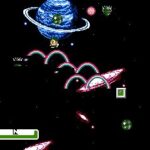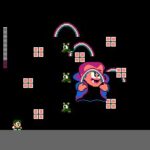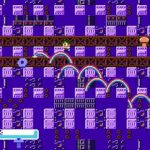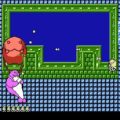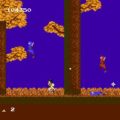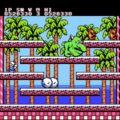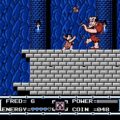Developer: Disco Publisher: Taito Release: 06/91 Genre: Platformer
Bubble Bobble is one of my favorite multiplayer games on the NES. The game is extremely fun with a friend and it also does not hurt that you need two players to see the true ending. But for as much as I love this series Rainbow Islands escaped my notice. I do not remember reviews in any of my magazines or ads, the game came and went as far as I knew. But playing it now the gameplay is still just as brilliant as the day it released. Rainbow Islands is a great game and every bit a worthy follow-up to its predecessor.
After the events of Bubble Bobble Bub and Bob have been restored to their human forms. But their adventures are not over! The citizens of the Rainbow Islands have been changed in to bubble dragons by the Boss of Shadow. The two brothers venture to the islands to save the people. Rainbow Islands has the subtitle the story of Bubble Bobble 2. It is the true sequel to the original and not the spinoff for the NES. Despite being the second title in the series it would receive a spinoff of its own, Parasol Stars: the Story of Bubble Bobble 3. This is in spite of the fact that Bubble Symphony is the canonical third game in the series. It’s some real Wonder Boy shit going on here I tell you.
The mechanics in Rainbow Islands is brand new. Rather than bubbles Bub and Bob create rainbows. These rainbows can damage enemies, pick up items, and function as makeshift platforms. Falling rainbows can also kill enemies and is a crucial element to see all the game has to offer. You cannot jump on a rainbow; doing so will cause it to fall. But you can walk on them as they persist for a few seconds and create more to ascend the levels. Resisting the urge to jump on them is hard if you are familiar with Bubble Bobble and you will probably die or fall repeatedly doing so. That learning curve is a killer. The goal in every level is to reach the top before the rising water causes you to drown. You have plenty of time before the water starts but once it does it is a harrowing experience.
The level design has a near perfect curve that gradually forces engagement with the mechanics. Initially there are many platforms so that you do not need to rely on rainbows as much. Soon however they become spaced out and you need to stack bridges to progress. Between careful enemy placement and traps you will need to have mastered the rainbow mechanics to ever see the later worlds. Every new world provides new challenges: Robot Land is the most platform heavy with some of the best levels in the game. Doh’s Island has the most aggressive and tricky enemies. Surprisingly the last world is a bit sedate compared to the journey getting there. The one area the game suffers compared to Bubble Bobble is its power-ups, at least in this version. The items have been paired back considerably but the general gameplay is good enough that they only add flavor.
Like many arcade games Rainbow Islands is tough. The difficulty curve is gradual but when it kicks in it does so hard. The later levels like Robot Island and Kiki KaiKai Island feature aggressive enemies that will box you in and give chase. The threat of rising water is not present at first as you have plenty of time. But as you progress and the levels become more complex, often challenging you to navigate spikes and large pits where any fall costs precious seconds it becomes more real. I was sweating a lot more late in the game but it never felt unfair. The boss battles are mostly fair outside of two that are cheap; the arcade lineage shows through hard there. You have to work to see this one through; luckily it is insanely fun!
The NES edition of Rainbow Islands is the most interesting of all. There are actually two versions of the game. Taito developed the version released in the US and Japan. Despite its creation by the original developers the Taito version differs from the arcade in a number of areas. Although the worlds are largely the same as the arcade the level design is different. The individual stages are longer, often significantly so. I actually like this as it gives the mechanics room to breathe and present new challenges. But it only has seven of the arcade’s ten worlds and has one original based on Kiki KaiKai. Ocean would create their version for the European market more faithful to the arcade. This version looks significantly better and has all the content. Honestly both are worth playing in my opinion although I will admit the Ocean game makes me a little jealous.
In Closing
Rainbow Islands is a fantastic action platformer every bit as good as the original and probably even better in my opinion. The mechanics are pitch perfect and the level design is engaging yet challenging. I came to this one late like River City Ransom and it remains just as good today as it was in 1991. Rainbow Islands is a great addition to any NES library, you have my word on that.


